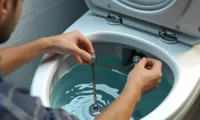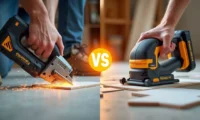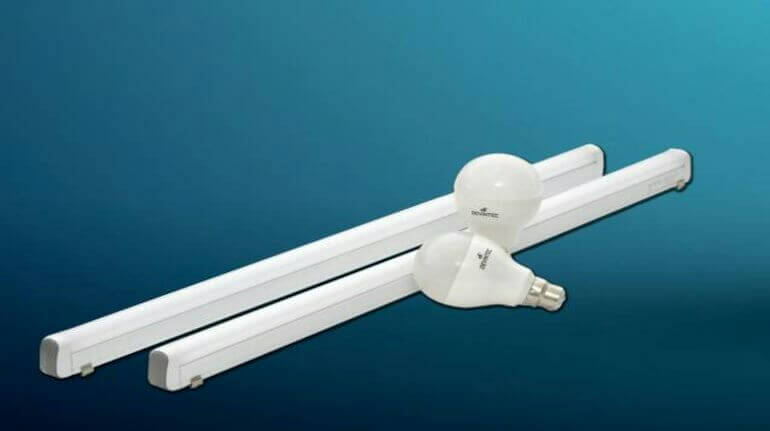Cordless caulk guns offer speed, consistency, and reduced hand fatigue – ideal for professionals and frequent users tackling large projects. Manual caulk guns provide precise control, affordability, and reliability without batteries—perfect for DIYers and occasional home repairs. For pros and heavy users, cordless wins. For budget-conscious homeowners doing small jobs, manual is your best bet.
- Caulk Gun
- Cordless Caulk Gun
- Who Should Use a Cordless Caulk Gun?
- Pros and Cons
- Pricing Range
- Ergonomics
- 💖 You Might Also Like
- Manual Caulk Gun
- Who Should Use a Manual Caulk Gun?
- Pros and Cons
- Pricing Range
- Ease of Use
- Cordless vs Manual Caulk Gun
- Cordless Caulk Gun vs Manual: What’s the Difference?
- ✨ More Stories for You
- Is a Cordless Caulk Gun Worth It?
- Do Professionals Prefer Cordless or Manual Caulking?
- Which Caulk Gun Is Best for Beginners?
- 🌟 Don't Miss These Posts
- How to Choose the Right Caulk Gun
- Material Quality and Construction
- Thrust Ratio (Manual Guns)
- Battery Power and Runtime (Cordless Guns)
- Variable Speed Control
- Anti-Drip Features
- Compatibility and Cartridge Size
- Brand Reliability and Warranty
- Price-to-Value Ratio
- How to Use a Caulk Gun Properly (Step-by-Step)
- Step-by-Step Application Process
- Common Mistakes to Avoid
- Safety Considerations
- Frequently Asked Questions (FAQs)
- Which caulk gun is easier to use for beginners?
- Which caulk gun is better for professional contractors?
- Do cordless caulk guns waste more caulk material?
- Is manual caulking hard for beginners to master?
- Does a cordless caulk gun work with all caulk types?
- How long do cordless caulk gun batteries typically last?
- Can you use a manual caulk gun for thick construction adhesive?
- Are expensive caulk guns worth the extra money?
- Conclusion
👉 Want exclusive cashback on tools? Check the best credit cards here to maximize your tool-buying budget.
Caulk Gun
A caulk gun is a handheld tool designed to dispense caulk, sealant, or adhesive from tubes in a controlled, even bead. The tool works by applying pressure to the tube’s plunger, forcing material through the nozzle tip. This simple mechanism transforms messy, inconsistent manual squeezing into smooth, professional-looking lines—whether you’re sealing gaps around windows, filling cracks in baseboards, or waterproofing bathroom fixtures.
Most caulk guns accommodate standard 10-ounce cartridges, though commercial models handle larger sizes. The gun holds the tube securely in a cradle, with a pressure rod that advances to push the plunger forward. What separates different caulk gun types is how that pressure gets applied—either through manual squeezing or battery-powered mechanisms.
Cordless Caulk Gun
A cordless caulk gun uses battery power to automatically dispense caulk with the pull of a trigger, eliminating the repetitive hand-squeezing motion required by manual models. Inside the tool, a motor drives the pressure rod forward at consistent speed, delivering smooth, even beads without physical exertion. Most cordless models feature variable speed triggers, allowing you to control flow rate with precision—slow for detailed corners, fast for long runs.
Who Should Use a Cordless Caulk Gun?
Cordless caulk guns shine for professionals, contractors, and serious DIYers tackling multiple rooms or large-scale projects. If you’re caulking more than 10 tubes in a session, installing windows throughout a new construction site, or spending hours on commercial sealing work, battery power becomes invaluable. The tool also benefits anyone with arthritis, hand injuries, or grip strength limitations who can’t comfortably operate manual guns for extended periods.
Pros and Cons
Advantages:
Speed: Cordless guns work 3-5 times faster than manual models, cutting project time dramatically. Where you’d spend 45 minutes manually caulking a bathroom, a cordless gun completes the job in 10-15 minutes.
Consistency: Battery-powered pressure maintains perfectly even flow rates, eliminating the uneven beads caused by varying hand pressure. Your work looks more professional, with fewer visible inconsistencies.
Reduced Fatigue: Zero hand squeezing means you can work all day without developing cramped fingers, sore forearms, or trigger-finger pain. This matters enormously on commercial jobs requiring dozens of tubes.
Precision Control: Variable speed triggers let you dial in exact flow rates for different materials and applications. Thick adhesives, thin sealants, detailed corners, or long runs—you adjust on the fly.
Disadvantages:
Battery Dependency: Dead batteries stop work completely. You’ll need backup batteries for all-day jobs, adding to your initial investment and creating charging management hassles.
Higher Cost: Quality cordless models start around $80-150, compared to $10-30 for manual guns. Budget-conscious homeowners face significant upfront costs.
Weight: Battery-powered tools weigh 3-5 pounds versus 1-2 pounds for manual guns. Extended overhead work becomes more tiring despite eliminating hand squeezing.
Maintenance: Batteries degrade over time, motors can fail, and electronic triggers add complexity. Manual guns have virtually no maintenance requirements.
Pricing Range
Entry-level cordless caulk guns start around $60-80 for basic homeowner models with minimal features. Mid-range professional tools run $100-180, offering better batteries, variable speed control, and durable construction. Premium contractor-grade models reach $200-300, featuring brushless motors, high-capacity batteries, and compatibility with larger cartridges.
👉 Ready to upgrade your caulking game? Browse cordless caulk guns on Amazon and compare top-rated models with verified reviews.
Battery costs add another consideration. Replacement batteries typically run $30-80 depending on capacity and brand. Many cordless guns use standard battery platforms shared with other power tools from the same manufacturer, potentially saving money if you’re already invested in that ecosystem.
Ergonomics
Despite their weight, cordless guns often feature superior ergonomic design compared to manual models. Pistol grips fit hands naturally, reducing wrist strain. The absence of repetitive squeezing eliminates the primary fatigue source, even though the tool itself weighs more. Balanced weight distribution keeps the center of gravity near your hand, minimizing arm strain during overhead application.
However, that extra weight matters on ladder work, scaffolding, or extended overhead caulking. Your shoulder and arm muscles tire from holding the heavier tool in position, even without the finger fatigue. Consider how much vertical work your projects involve when weighing this tradeoff.
👉 Finance your tool upgrades smartly—check the best cashback credit cards for tool purchases and maximize your rewards.
💖 You Might Also Like
Manual Caulk Gun
A manual caulk gun relies entirely on hand pressure applied through a trigger mechanism to push caulk from the tube. Each trigger squeeze advances the pressure rod incrementally, forcing material through the nozzle. The tool uses mechanical leverage to multiply your hand force, making it easier than squeezing tubes directly—but still requiring continuous physical effort throughout application.
Manual guns come in three main types: rod-style (basic, inexpensive), ratchet-style (smoother flow with stepless advancement), and smooth-rod (professional models with friction drive for ultimate control). The pressure rod design determines how smooth and consistent your bead will be.
Who Should Use a Manual Caulk Gun?
Manual caulk guns suit occasional users, budget-conscious homeowners, and DIYers tackling small to medium projects. If you’re sealing one bathroom, weatherproofing a few windows, or handling repairs that require just 1-5 tubes of caulk, manual guns deliver excellent results without the expense or complexity of battery power. They’re also perfect for detail-oriented work where you want maximum tactile feedback and precise control.
Pros and Cons
Advantages:
Affordability: Quality manual guns cost $10-30, with basic models as low as $5-8. This accessible pricing removes barriers for homeowners and beginners.
Control: Direct connection between your hand and the material flow provides exceptional tactile feedback. You feel exactly how much pressure you’re applying, making it easier to achieve precision on delicate work.
Reliability: No batteries to die, no motors to fail, no electronics to malfunction. A manual gun works every time you pick it up, even after years of storage.
Lightweight: At 1-2 pounds, manual guns reduce arm fatigue during overhead work, even though hand fatigue increases from trigger squeezing.
Simplicity: Load, cut, squeeze—that’s it. No charging, no speed adjustments, no settings to configure. Perfect for users who want straightforward tools.
Disadvantages:
Hand Fatigue: Repetitive trigger squeezing creates finger cramps, hand soreness, and forearm burn, especially with thick adhesives or extended sessions.
Slower Speed: Manual application takes significantly longer, potentially tripling project time on large jobs compared to cordless models.
Inconsistent Flow: Varying hand pressure creates uneven beads with thick spots and thin spots. Achieving professional consistency requires practice and careful attention.
Physical Limitations: Users with arthritis, carpal tunnel, or reduced grip strength may struggle or find manual guns unusable for anything beyond tiny projects.
Pricing Range
Basic rod-style manual guns: $5-12 (acceptable for occasional use, but expect rougher performance)
Mid-grade ratchet guns: $12-25 (smooth operation for typical homeowner needs)
Professional smooth-rod guns: $25-45 (contractor-quality precision and durability)
The price differences reflect build quality, materials, and mechanism sophistication. Investing in a $20-30 manual gun dramatically improves your experience compared to the cheapest models, while still costing a fraction of cordless options.
👉 Get the job done without breaking the bank – shop manual caulk guns on Amazon and read real user experiences before buying.
Ease of Use
Manual guns have virtually no learning curve—load a tube, squeeze the trigger, and material comes out. This simplicity appeals to beginners and infrequent users who don’t want to master tool settings or battery management. However, achieving truly professional-looking beads requires developing consistent trigger pressure, proper gun angle, and steady hand movement—skills that take practice.
The physical effort required varies dramatically with caulk viscosity. Thin latex caulk flows easily with minimal squeeze force. Thick adhesives, construction adhesives, or cold-weather sealants demand much harder squeezing, multiplying hand fatigue. Temperature also matters—cold materials require more force to dispense.
Cordless vs Manual Caulk Gun
| Feature | Cordless Caulk Gun | Manual Caulk Gun |
|---|---|---|
| Speed | 3-5x faster; completes large jobs in fraction of time | Slower; requires more project time |
| Control | Excellent with variable speed triggers; consistent flow | Excellent tactile feedback; requires steady hand |
| Accuracy | Very high; motor maintains even pressure | Good with practice; varies with user technique |
| Durability | Moderate; batteries degrade, motors can fail | Excellent; simple mechanics last decades |
| Fatigue | Minimal hand fatigue; some arm fatigue from weight | Significant hand/finger fatigue; less arm strain |
| Price | $60-300 (plus battery costs) | $5-45 |
| Ideal For | Professionals, large projects, commercial work, users with grip limitations | DIYers, small projects, occasional use, budget-conscious buyers |
| Buy Link | Cordless on Amazon | Manual on Amazon |
Cordless Caulk Gun vs Manual: What’s the Difference?
The fundamental difference between cordless and manual caulk guns lies in their power source and pressure application method. Cordless models use battery-powered motors to automatically advance the pressure rod at consistent speeds, while manual guns require continuous trigger squeezing to manually push material through mechanical leverage.
This core distinction cascades into practical differences across every aspect of use:
Application Speed: A cordless gun’s motor pushes caulk at steady, adjustable rates without waiting for repeated trigger squeezes. You move the gun continuously along your work surface while material flows at consistent speed. Manual guns require constant squeezing, creating a rhythm of squeeze-pause-squeeze that slows overall progress.
Physical Demand: Cordless guns eliminate repetitive hand motion entirely, though their 3-5 pound weight increases arm and shoulder strain. Manual guns reverse this—minimal weight but significant finger and forearm fatigue from continuous trigger pressure.
Consistency: Battery power delivers perfectly even pressure throughout application, producing uniform beads without thick or thin spots. Manual pressure varies subtly with each squeeze and as your hand tires, creating less consistent results unless you’re highly practiced.
Complexity: Cordless guns add batteries, motors, speed controls, and electronic components that require charging, maintenance, and eventual replacement. Manual guns offer pure mechanical simplicity—nothing to charge, nothing to break electronically.
👉 Before you decide, compare features and prices on cordless caulk guns at Amazon to see what fits your needs and budget.
The choice essentially boils down to trading money and complexity for speed and comfort, or accepting slower, more physically demanding work in exchange for simplicity and affordability.
✨ More Stories for You
Is a Cordless Caulk Gun Worth It?
A cordless caulk gun is absolutely worth it if you regularly use 10+ tubes per project, work professionally in construction or remodeling, or have physical limitations that make manual squeezing painful.
The time savings and fatigue reduction justify the $80-200 investment when you’re caulking multiple rooms, working all-day commercial jobs, or tackling large-scale weatherization projects. Professional contractors typically recover the tool cost within 1-2 jobs through increased productivity.
However, cordless guns aren’t worth the investment for occasional homeowners sealing a few windows annually or DIYers handling small repair projects. If you’re using 1-3 tubes once or twice yearly, a $15-25 manual gun delivers perfectly adequate results while saving $100+. The battery management, charging requirements, and additional complexity add unnecessary overhead for infrequent use.
Consider these tipping points:
Volume threshold: Using more than 8-10 tubes per project makes cordless worthwhile through time savings alone.
Frequency threshold: Caulking monthly or more frequently justifies the investment.
Physical threshold: Any hand pain, arthritis, or grip issues make cordless invaluable regardless of project size.
Professional threshold: If you charge for caulking services, cordless pays for itself through faster job completion.
One often-overlooked benefit: cordless guns enable multi-hour projects that would be physically impossible with manual guns. A bathroom remodel requiring 15-20 tubes becomes manageable rather than torturous when you eliminate hand fatigue.
Do Professionals Prefer Cordless or Manual Caulking?
Professional contractors overwhelmingly prefer cordless caulk guns for high-volume commercial work, new construction, and large-scale remodeling projects where speed and efficiency directly impact profitability. However, many pros keep quality manual guns in their toolboxes for detail work, touch-ups, and situations where cordless tools prove impractical.
The professional preference breaks down by specialty:
General contractors and remodelers: Primarily cordless for volume work, with manual backup for precision details.
Window installers: Almost exclusively cordless due to high tube counts per job.
Painters and trim carpenters: Often prefer manual guns for caulking nail holes and detail work where precise control matters more than speed.
Commercial construction: Cordless dominates due to the massive scale of material application.
Professional-grade cordless guns feature brushless motors, high-thrust ratios (400+ pounds), compatibility with 20-ounce and larger cartridges, and platform compatibility with existing tool batteries. These capabilities matter enormously on jobsites where dozens of tubes get used daily.
That said, experienced professionals develop remarkable manual gun technique that approaches cordless consistency. A skilled tradesperson with a smooth-rod manual gun can produce beautiful beads—just not at the same speed or with the same endurance as battery power provides.
👉 Maximize your tool investments with smart financing—explore the best credit cards for tool purchases and earn cashback on every dollar spent.
Which Caulk Gun Is Best for Beginners?
Manual caulk guns are best for beginners because they offer simple operation, low financial risk, immediate tactile feedback, and no technical complexity to master. A quality $15-25 manual gun lets new users learn fundamental caulking techniques—proper gun angle, consistent hand speed, material preparation, and clean application—without the distraction of speed settings, battery management, or expensive equipment they might not use frequently.
Starting with manual guns builds important foundational skills. You develop a feel for how different caulk viscosities behave, learn to read material flow, and understand the relationship between pressure and bead size. This hands-on education translates directly if you later upgrade to cordless models.
For absolute beginners, I recommend:
Ratchet-style manual guns in the $12-20 range from reputable brands like Newborn or Albion. These provide smooth operation without the expense or complexity of professional smooth-rod models, while avoiding the frustration of ultra-cheap rod-style guns.
Starting with easier materials: Practice with standard latex caulk rather than thick adhesives or polyurethane sealants that require much more hand pressure.
Small initial projects: Begin with a single room or a few windows to build confidence before tackling whole-house jobs.
The mistake many beginners make is buying the absolute cheapest $5-8 guns, which deliver frustrating, inconsistent performance that makes learning harder. Spending an extra $10-15 on a mid-grade manual gun dramatically improves the learning experience.
Once you’ve completed 3-4 projects and confirmed you’ll continue caulking regularly, that’s the time to evaluate whether cordless makes sense for your evolving needs.
🌟 Don't Miss These Posts
How to Choose the Right Caulk Gun
Selecting the right caulk gun requires evaluating your project requirements, frequency of use, budget constraints, and physical capabilities. This systematic approach ensures you invest in tools that match your actual needs rather than getting swayed by features you’ll never use or skimping in ways that create frustration.
Material Quality and Construction
Look for guns with metal frames rather than plastic bodies, especially for manual models. Steel or aluminum construction provides stability, reduces flex during application, and withstands years of use. Plastic guns work adequately for ultra-light residential use but crack, warp, and fail under regular stress.
The pressure rod matters enormously. Smooth rods provide better control than ratchet mechanisms. In cordless models, look for metal drive components rather than plastic gears that wear quickly.
Thrust Ratio (Manual Guns)
Thrust ratio indicates mechanical advantage—how much the gun multiplies your hand force. Higher ratios reduce the squeezing effort required:
10:1 ratio: Basic, suitable only for thin latex caulk
12:1 ratio: Standard for typical homeowner use
18:1-26:1 ratio: Professional-grade, handles thick adhesives easily
For general DIY work, aim for at least 12:1 ratio. Professional contractors should consider 18:1 or higher, especially when working with construction adhesives.
Battery Power and Runtime (Cordless Guns)
Battery voltage determines power output. Most cordless caulk guns use:
12V batteries: Adequate for standard caulk, may struggle with thick adhesives
18V batteries: Professional standard, handles all material types
20V batteries: Maximum power for demanding commercial use
Runtime varies dramatically by battery capacity (measured in amp-hours). A 2.0Ah battery might push 8-12 tubes before recharging. A 4.0Ah battery handles 20-30 tubes. For professional use, always buy at least two batteries so one charges while you work with the other.
Check whether the cordless gun uses a battery platform you already own from other power tools. This compatibility can save hundreds of dollars versus buying into a new battery ecosystem.
Variable Speed Control
Quality cordless guns feature variable-speed triggers that let you adjust flow rate on the fly. This matters enormously when switching between materials, working in corners versus long runs, or adapting to different weather conditions that affect material viscosity.
Look for models with:
Electronic speed selection: Multiple preset speeds for different applications
Trigger sensitivity: Proportional control based on how far you pull the trigger
Speed lock: Ability to set and maintain constant speed for long runs
Budget cordless models often lack true variable speed, offering only single-speed operation that limits their versatility.
Anti-Drip Features
Professional-grade guns include pressure release mechanisms that automatically retract the pressure rod slightly when you release the trigger. This prevents material from continuing to ooze after you’ve finished a bead—a common frustration with basic guns that creates messy drips and material waste.
This feature alone can justify spending $10-15 more on a better manual gun or choosing a higher-quality cordless model.
Compatibility and Cartridge Size
Ensure the gun accommodates your intended cartridge sizes. Most guns handle standard 10-ounce tubes, but verify compatibility with:
Large 20-29 ounce cartridges for commercial work
Sausage packs (bulk caulk without tubes) for maximum material economy
Specialty tubes with unusual dimensions
Cordless models typically specify maximum cartridge size and compatible formats. Professional guns offer more versatility.
Brand Reliability and Warranty
Established brands like Milwaukee, DeWalt, Makita, Ryobi (cordless) and Newborn, Albion, COX (manual) build reputations on consistent quality and stand behind their tools with warranties. Unknown brands selling through online marketplaces often fail prematurely and offer no recourse.
Look for:
Minimum 1-year warranties on cordless guns
Lifetime warranties on quality manual guns (many offer this)
Accessible customer service for troubleshooting
Replacement parts availability for long-term maintenance
Price-to-Value Ratio
Avoid both extremes. The cheapest tools create frustration and often need replacement within 1-2 projects. The most expensive tools include features most users never need.
Sweet spots by category:
Manual guns: $15-30 range offers excellent performance for typical DIY use
Cordless guns: $100-150 range provides reliable performance without premium pricing
Professional tools: $35-50 manual or $180-250 cordless justifies investment through durability
👉 Ready to find your perfect caulk gun? Browse manual models on Amazon and compare features, prices, and user ratings across top brands.
How to Use a Caulk Gun Properly (Step-by-Step)
Using a caulk gun properly involves preparing the tube correctly, maintaining consistent technique, and working at steady speed for professional-looking results. Start by cutting the tube nozzle at a 45-degree angle—the cut position determines bead size, with cuts closer to the tip producing thinner beads. Pierce the inner seal with a nail or the gun’s built-in puncture tool, then load the tube into the gun by retracting the pressure rod fully and inserting the cartridge into the cradle.
Step-by-Step Application Process
1. Prepare the Surface Clean the area thoroughly, removing old caulk, dirt, dust, and moisture. Use a utility knife or caulk removal tool to scrape away existing material. Dry completely—caulk adheres poorly to damp surfaces. For optimal adhesion, wipe with isopropyl alcohol and let dry.
2. Load and Test After loading the tube and puncturing the seal, squeeze (or trigger) the gun over cardboard or scrap material until caulk flows steadily. This purges air bubbles and lets you verify proper operation before starting work.
3. Position Correctly Hold the gun at a consistent 45-degree angle to the surface, with the nozzle pointing in your direction of travel. This angle pushes material into gaps rather than just laying it on top. Keep the nozzle tip touching or very close to the surface.
4. Maintain Steady Speed Move the gun smoothly and continuously at consistent speed—about one foot every 3-4 seconds for standard beads. Avoid stopping mid-bead, which creates visible bumps and thickness variations. Practice on hidden areas first to develop rhythm.
5. Apply Consistent Pressure For manual guns, maintain steady trigger pressure throughout each bead. For cordless guns, set appropriate speed and let the tool handle consistency. Varying pressure creates uneven beads with thick and thin sections.
6. Tool the Bead Immediately after applying caulk, smooth it with your finger (for latex caulk), a wet tool, or a caulk finishing tool. Work quickly—you typically have 5-15 minutes before material begins skinning over. One smooth pass produces better results than multiple passes.
7. Release Pressure After finishing a bead, release trigger pressure on manual guns or activate the reverse function on cordless models to stop material flow. This prevents dripping and oozing that wastes material and creates mess.
Common Mistakes to Avoid
Cutting the nozzle wrong: Too large an opening wastes material and creates oversized beads. Too small restricts flow and requires excessive pressure.
Moving too fast: Creates gaps, thin spots, and inadequate material in joints.
Moving too slow: Produces thick, wasteful beads that are difficult to tool smooth.
Skipping surface prep: Caulk peels away from dirty, dusty, or oily surfaces within months.
Over-tooling: Excessive smoothing removes too much material from joints, reducing effectiveness.
Wrong caulk type: Using interior latex caulk outdoors or general-purpose caulk in showers leads to premature failure.
Safety Considerations
Wear safety glasses when cutting nozzle tips—plastic shards can fly toward your eyes. Work in ventilated areas when using solvent-based caulks or adhesives. Read material safety data sheets for specific products, as some contain hazardous chemicals requiring respirator protection.
Keep rags and cleanup materials handy to address mistakes immediately before caulk cures. Most latex caulk cleans easily with water within 20 minutes of application but becomes nearly impossible to remove after curing.
Frequently Asked Questions (FAQs)
Which caulk gun is easier to use for beginners?
Manual caulk guns are easier for beginners because they require no battery charging, feature straightforward operation, and provide direct tactile feedback that helps you learn proper technique and pressure control without technical complications.
Which caulk gun is better for professional contractors?
Cordless caulk guns are better for professional contractors because they dramatically increase productivity, reduce hand fatigue during all-day use, and deliver consistent results across dozens of tubes, quickly recovering their higher cost through time savings.
Do cordless caulk guns waste more caulk material?
Quality cordless caulk guns with anti-drip mechanisms waste less material than cheap manual guns by automatically stopping flow when you release the trigger, preventing the continuous oozing that occurs with manual models lacking pressure release features.
Is manual caulking hard for beginners to master?
Manual caulking requires practice but isn’t particularly hard for beginners—most users achieve acceptable results after completing one or two small projects, though developing truly professional-looking consistency takes additional experience with pressure control and hand speed.
Does a cordless caulk gun work with all caulk types?
Cordless caulk guns work with all standard caulk types including latex, silicone, polyurethane, and construction adhesives, though high-thrust models (400+ pounds) handle thick, cold, or heavy-bodied materials more effectively than lower-powered budget versions.
How long do cordless caulk gun batteries typically last?
Cordless caulk gun batteries typically last through 15-30 standard 10-ounce tubes per charge depending on battery capacity and material viscosity, with higher amp-hour batteries and thinner caulks providing longer runtime before recharging.
Can you use a manual caulk gun for thick construction adhesive?
You can use manual caulk guns for thick construction adhesive if the gun has a high thrust ratio (18:1 or greater), though even professional manual guns require significantly more hand strength and create more fatigue than cordless models when dispensing viscous materials.
Are expensive caulk guns worth the extra money?
Expensive caulk guns justify their cost through superior build quality, smoother operation, better consistency, and longer lifespan—a $25 manual gun or $150 cordless model typically outperforms budget alternatives dramatically enough to save time and frustration over multiple projects.
👉 Smart tool shopping means smart financing—check credit card offers to earn cashback on your next hardware store run.
Conclusion
Choosing between a cordless caulk gun and a manual model ultimately depends on your specific situation—project scale, usage frequency, budget, and physical capabilities all factor into the right decision. Cordless guns dominate when speed, consistency, and fatigue reduction matter most, making them ideal for professionals, frequent users, and anyone tackling large-scale projects with 10+ tubes. Their $80-250 investment pays dividends through dramatically reduced completion time and virtually eliminated hand strain.
Manual caulk guns remain the perfect choice for occasional users, budget-conscious homeowners, and DIYers handling small to medium projects with 1-5 tubes. Their $10-30 price point, mechanical simplicity, and reliable performance deliver excellent results without the complexity or expense of battery power. For infrequent use, the savings and straightforward operation outweigh any speed disadvantages.
For most readers, I recommend starting with a quality $15-25 manual gun to learn fundamental caulking skills. Once you’ve completed several projects and established regular tool use, evaluate whether upgrading to cordless makes sense. Many users find the manual gun continues serving them perfectly for years, while others quickly realize that battery power transforms their project experience.
👉 Ready to make your choice? Shop cordless caulk guns on Amazon or browse manual models to compare options and read verified buyer reviews.
👉 Make every tool purchase count—check the best credit cards for cashback rewards and turn your home improvement spending into savings.
























